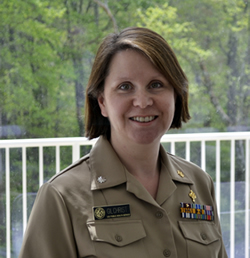Selected Category: Home & Recreational Safety
Categories: CDC Injury Center, Home & Recreational Safety, Motor Vehicle Safety, Traumatic Brain Injury, Violence Prevention
September 11th, 2012 9:04 am ET -
Dr. Linda C. Degutis, DrPH, MSN
 I still vividly remember my days working at a trauma center, treating victims of violence and traumatic events and working with communities to help prevent violence and injuries from happening in the first place.
I still vividly remember my days working at a trauma center, treating victims of violence and traumatic events and working with communities to help prevent violence and injuries from happening in the first place.
I can clearly recall the faces and voices of children who came to the emergency department with injuries, and can still see the reactions of the parents who were told that their child had died from injuries; injuries that could have been prevented.
 Post a Comment -
Read more
Post a Comment -
Read more

Categories: CDC Injury Center, Home & Recreational Safety, Motor Vehicle Safety, Traumatic Brain Injury, Violence Prevention
September 5th, 2012 3:58 pm ET -
 Guest Blogger: Wendy Holmes, MS
Guest Blogger: Wendy Holmes, MS
Back-to-school season seems to usher a school bus load of paper into our home. It starts with a cheerful postcard showing my child’s new teacher. Then comes the packet with the welcome letter, transportation form, lunch form, contact information form, medical information form, the Parent Teacher Association form, the…well, you get the idea.
 1 Comment -
Read more
1 Comment -
Read more

Categories: CDC Injury Center, Home & Recreational Safety
July 31st, 2012 10:23 am ET -
Guest blogger: Julie Gilchrist, MD

Julie Gilchrist, MD
People who work in hospitals and emergency departments can tell you. Treating kids is a hard job—especially when a child comes in with a serious injury that could have been prevented. I still get sad remembering some of the cases I worked on as a doctor in Philadelphia—many of my stories don’t have happy endings.
 2 Comments -
Read more
2 Comments -
Read more

Categories: CDC Injury Center, Home & Recreational Safety, Motor Vehicle Safety, Traumatic Brain Injury
June 13th, 2012 10:19 am ET -
We are excited to see how injury and violence professionals, students, and the general public can showcase what injury and violence prevention looks like in their own communities through the “Seeing My World through a Safer Lens” video contest. This challenge will award $500 per category (Student View, Injury and Violence Professional View, and General Public View) for the video that best reflects a prevention story about Violence Prevention, Home and Recreational Safety, Motor Vehicle Safety, or Traumatic Brain Injury.
 1 Comment -
Read more
1 Comment -
Read more

Categories: CDC Injury Center, Home & Recreational Safety
May 22nd, 2012 11:12 am ET -
Dr. Linda C. Degutis, DrPH, MSN
Starting from the time when drawings on cave walls portrayed tales about human life, people have been using images to tell their stories. Even a simple image can quickly communicate thousands of details, increase understanding about a difficult topic, or help us comprehend the relevance of complex data.
 1 Comment -
Read more
1 Comment -
Read more

Categories: CDC Injury Center, Home & Recreational Safety, Injury Response, Motor Vehicle Safety, Traumatic Brain Injury, Violence Prevention
January 23rd, 2012 4:29 pm ET -
Dr. Linda C. Degutis, DrPH, MSN

Please visit the CDC Injury Center 20th Anniversary web site for toolkits, talking points, and other resources to help us commemorate our 20 years, and to spread the word about injury and violence prevention.
I have many stories that I could tell about injuries and violence, from both my professional and personal lives. One of my nephews was diagnosed with depression when he was in high school. He was treated, eventually finished school, and graduated from college at the age of 25. He was accepted to law school, but tragically, he died by suicide shortly after receiving his acceptance letter. Working in trauma and emergency care for many years, I saw the impacts that deaths and injuries had on families like mine. These experiences compelled me to do something to prevent other families from suffering. Being at CDC where so many people are dedicated to preventing these kinds of tragedies gives me an opportunity to ensure that fewer families will experience such loss and disruption.
 2 Comments -
Read more
2 Comments -
Read more

Categories: CDC Injury Center, Home & Recreational Safety
December 12th, 2011 10:57 am ET -
 Guest blogger: Christopher M. Jones, PharmD, MPH, LCDR, U.S. Public Health Service
Guest blogger: Christopher M. Jones, PharmD, MPH, LCDR, U.S. Public Health Service
How big a problem is prescription drug overdose?
We see the country’s surging number of deaths involving prescription drugs as an epidemic. In 2008, the most recent year for which we have national figures, more than 36,000 people died of drug overdoses in the U.S., and more than 20,000 of these overdose deaths were from prescription drugs. We have seen this number steadily increase over the last decade.
 17 Comments -
Read more
17 Comments -
Read more

Categories: CDC Injury Center, Home & Recreational Safety
June 30th, 2011 8:00 am ET -
Dr. Linda C. Degutis, DrPH, MSN
As summer begins, you may be thinking of vacation plans—spending time with family and friends, visiting favorite vacation places, and exploring new locations and activities. Many of us can recall heading back to school in the fall and being faced with the inevitable report on “what I did on my summer vacation.” I’m not sure that this is still the norm, with near instantaneous communication about travel and other activities and places visited, but however you report your summer activities, we hope that your report will include happy memories. A key ingredient to a good vacation is staying safe, no matter what you do.
 1 Comment -
Read more
1 Comment -
Read more

Categories: CDC Injury Center, Home & Recreational Safety, Injury Response, Motor Vehicle Safety, Traumatic Brain Injury, Violence Prevention
April 14th, 2011 3:24 pm ET -
Dr. Linda C. Degutis, DrPH, MSN
 Last week, National Public Health Week (NPHW) focused on injury and violence prevention – keeping people safe and realizing the goal of ensuring that people live injury-free. It was a week where a great deal of attention was focused on injury and violence and the health and societal effects of both. The joint Safe States Alliance, Society for the Advancement of Violence and Injury (SAVIR) & CDC’s Injury Center Conference in Coralville, Iowa brought together over 350 injury and violence prevention practitioners and researchers, creating a forum for research informing practice and practice informing research, and an opportunity to explore evidence-based policy and practice. It was a great week, and the first time that NPHW focused on injury and violence prevention.
Last week, National Public Health Week (NPHW) focused on injury and violence prevention – keeping people safe and realizing the goal of ensuring that people live injury-free. It was a week where a great deal of attention was focused on injury and violence and the health and societal effects of both. The joint Safe States Alliance, Society for the Advancement of Violence and Injury (SAVIR) & CDC’s Injury Center Conference in Coralville, Iowa brought together over 350 injury and violence prevention practitioners and researchers, creating a forum for research informing practice and practice informing research, and an opportunity to explore evidence-based policy and practice. It was a great week, and the first time that NPHW focused on injury and violence prevention.
 9 Comments -
Read more
9 Comments -
Read more

Categories: CDC Injury Center, Home & Recreational Safety, Injury Response, Motor Vehicle Safety, Traumatic Brain Injury, Violence Prevention
April 4th, 2011 8:00 am ET -
Dr. Linda C. Degutis, DrPH, MSN

Dr. Linda C. Degutis, DrPH, MSN
Looking back at my experience in the field of injury prevention and control, I can easily see how important partnerships have been in our efforts to decrease the toll that injury takes on people of all ages. We have come a long way over the past few decades, but face new challenges in enabling people to live injury free lives. We face the challenges of an aging population, with increased risk of falls; various forms of violence, including violence among youth which so often has its roots in early childhood, and has health impacts far beyond the immediate effect of injuries related to violence; motor vehicle related injuries that affect vehicle occupants as well as those who share the road with motor vehicles; emerging problems with narcotic prescription drug abuse and overdoses; suicide and injuries with long-term effects among our troops who are returning from their missions. While efforts in these areas may involve different partners and different approaches, they are all amenable to a public health approach.
 4 Comments -
Read more
4 Comments -
Read more

 I still vividly remember my days working at a trauma center, treating victims of violence and traumatic events and working with communities to help prevent violence and injuries from happening in the first place.
I still vividly remember my days working at a trauma center, treating victims of violence and traumatic events and working with communities to help prevent violence and injuries from happening in the first place. Guest Blogger: Wendy Holmes, MS
Guest Blogger: Wendy Holmes, MS


 Last week,
Last week, 

